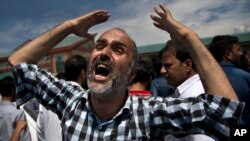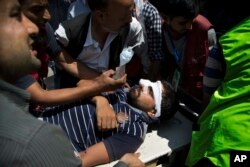A young protester was killed Wednesday in an anti-India demonstration in Kashmir as India's home minister began a two-day visit to the Himalayan valley to try to defuse deadly protests that have engulfed the region for more than six weeks.
The protester died as troops fired shotguns and tear gas to disperse thousands of people defying a curfew on the streets in Pulwama district. At least 20 civilians and troops were injured.
Indian officials described Home Minister Rajnath Singh's visit as an outreach to the troubled region, which is facing its worst unrest in six years. He tweeted that he would “interact with civil society groups, political parties and other stakeholders.”
Kashmir’s former chief minister, Omar Abdullah, who met with Singh, said he stressed the need for talks to calm the tensions.
“We believe that it is very important that a political dialogue be initiated with the stakeholders of Jammu and Kashmir,” Abdullah said.
The visit comes days after Prime Minister Narendra Modi called for dialogue and a permanent solution to the problems in the restive region.
Sixty-seven people have died and hundreds have been injured in massive street protests that erupted after a Kashmiri militant, Burhan Wani, was killed by Indian security forces last month.
To control the deteriorating security situation, paramilitary troops, which left the region 12 years ago after a violent separatist insurgency abated, have again been deployed in the valley.
Among those who have appealed for calm is Indian army chief Dalbir Singh. On Tuesday, he urged people to help restore peace and said troops had been told to exercise “maximum restraint” while dealing with protesters.
Kashmir has been virtually shut down for the past six weeks, with a curfew clamped on much of the region. Schools and markets remain closed, and there are reports of widespread shortages.
Political commentators remained skeptical that Singh’s outreach would calm the valley.
Manoj Joshi at New Delhi’s Observer Research Foundation pointed out that the ruling Hindu nationalist Bharatiya Janata Party has always opposed the Muslim majority region's demand for more autonomy. He said he saw no early end to the unrest in Kashmir, which has always simmered with anti-India sentiment.
“Burhan Wani’s killing was just a trigger of a situation. You will have other triggers down the line,” he said.
Kashmir is divided between India and Pakistan, and New Delhi blames the unrest in the region on Islamic militant groups based in Pakistan.









